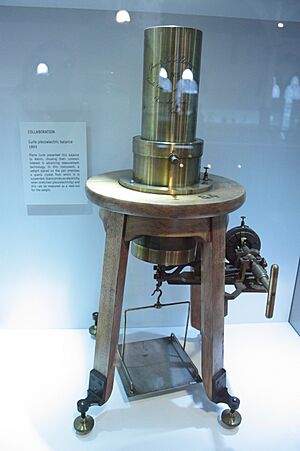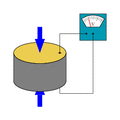Piezoelectricity facts for kids
Imagine a special kind of material that can make electricity just by being squeezed or bent! This is what a piezoelectric material does. When you change its shape, even a tiny bit, it creates a small electrical voltage. This amazing property means these materials can turn movement or pressure into electrical energy.
Contents
What is Piezoelectricity?
Piezoelectricity is a cool effect found in certain materials, like some crystals and ceramics. The word "piezo" comes from a Greek word meaning "squeeze" or "press." So, it literally means "electricity from pressure."
When you press on a piezoelectric material, its tiny internal structure changes. This change pushes around the electrical charges inside, making one side of the material become positively charged and the other side negatively charged. This difference in charge creates an electric voltage. It's like a tiny battery that gets charged by squishing it!
How Does it Work?
Think of the atoms inside a piezoelectric material as being arranged in a very specific, organized way. When you apply pressure, this arrangement gets slightly squished or stretched. Even a tiny change, like less than one percent of its size, can be enough to create electricity.
What's really interesting is that the total size of the material doesn't actually change. If you have a block of this material, its overall volume stays the same. Instead, its dimensions along different directions (like length, width, and height) might change. For example, a tall, thin block might become shorter and wider when squeezed, but its total space it takes up remains the same.
Making Electricity from Movement
The amount of electricity a piezoelectric material can make depends on the material itself and how much it's deformed. Some materials can produce enough electricity to power small devices. For instance, a small piece might generate enough power for a tiny light or a sensor. This ability to turn movement into power is called "energy harvesting."
Where Do We Use Piezoelectric Materials?
Piezoelectric materials are used in many everyday things, even if you don't realize it! They are super useful because they can both create electricity from movement and create movement from electricity.
Everyday Gadgets
- Lighters: Many gas lighters use a tiny piezoelectric crystal. When you press the button, a hammer hits the crystal, creating a spark that lights the gas.
- Speakers and Buzzers: In small speakers and buzzers, a piezoelectric disk vibrates when electricity is applied to it. This vibration creates sound waves that we hear.
- Microphones: Some microphones use piezoelectric materials to turn sound vibrations into electrical signals.
- Guitar Pickups: Electric guitars can use piezoelectric pickups to sense the vibrations of the strings and turn them into electrical signals that can be amplified.
Cool Technology
- Sensors: Because they create a voltage when pressure is applied, piezoelectric materials are great for making sensors. They can detect tiny forces, vibrations, or even changes in temperature.
- Medical Imaging: In ultrasound machines, piezoelectric crystals send out sound waves and then listen for the echoes. This helps doctors see inside the body without surgery.
- Energy Harvesting: Scientists are looking into using piezoelectric materials to collect energy from things like footsteps, vibrations from bridges, or even the movement of waves in the ocean. This could power small devices or sensors without needing batteries.
- Atomic Force Microscopes: These super-powerful microscopes use tiny piezoelectric parts to move a probe with incredible precision, allowing scientists to see individual atoms.
Who Discovered Piezoelectricity?
The piezoelectric effect was first discovered in 1880 by two French brothers, Pierre Curie and Jacques Curie. They were studying crystals and noticed that when they squeezed certain ones, like quartz, they produced an electric charge. They also found the opposite effect: if you applied electricity to these crystals, they would change shape!
Their discovery opened up a whole new field of physics and led to many important inventions that we still use today.
Images for kids
-
Many rocket-propelled grenades used a piezoelectric fuse. Pictured, a Russian RPG-7
See also
 In Spanish: Piezoelectricidad para niños
In Spanish: Piezoelectricidad para niños







